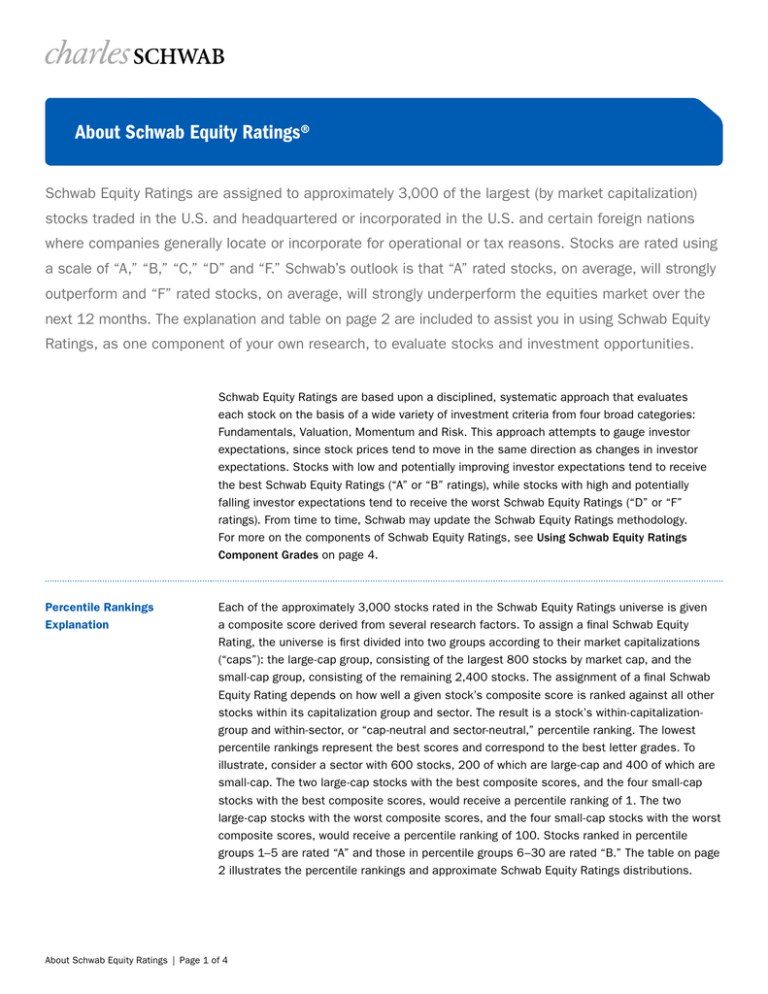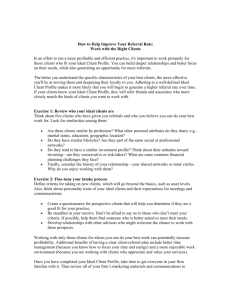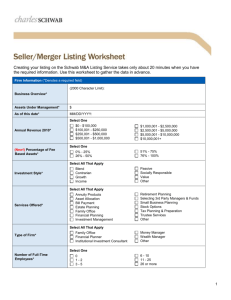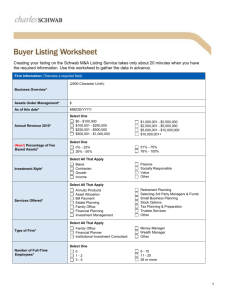
About Schwab Equity Ratings®
Schwab Equity Ratings are assigned to approximately 3,000 of the largest (by market capitalization)
stocks traded in the U.S. and headquartered or incorporated in the U.S. and certain foreign nations
where companies generally locate or incorporate for operational or tax reasons. Stocks are rated using
a scale of “A,” “B,” “C,” “D” and “F.” Schwab’s outlook is that “A” rated stocks, on average, will strongly
outperform and “F” rated stocks, on average, will strongly underperform the equities market over the
next 12 months. The explanation and table on page 2 are included to assist you in using Schwab Equity
Ratings, as one component of your own research, to evaluate stocks and investment opportunities.
Schwab Equity Ratings are based upon a disciplined, systematic approach that evaluates
each stock on the basis of a wide variety of investment criteria from four broad categories:
Fundamentals, Valuation, Momentum and Risk. This approach attempts to gauge investor
expectations, since stock prices tend to move in the same direction as changes in investor
expectations. Stocks with low and potentially improving investor expectations tend to receive
the best Schwab Equity Ratings (“A” or “B” ratings), while stocks with high and potentially
falling investor expectations tend to receive the worst Schwab Equity Ratings (“D” or “F”
ratings). From time to time, Schwab may update the Schwab Equity Ratings methodology.
For more on the components of Schwab Equity Ratings, see Using Schwab Equity Ratings
Component Grades on page 4.
Percentile Rankings
Explanation
Each of the approximately 3,000 stocks rated in the Schwab Equity Ratings universe is given
a composite score derived from several research factors. To assign a final Schwab Equity
Rating, the universe is first divided into two groups according to their market capitalizations
(“caps”): the large-cap group, consisting of the largest 800 stocks by market cap, and the
small-cap group, consisting of the remaining 2,400 stocks. The assignment of a final Schwab
Equity Rating depends on how well a given stock’s composite score is ranked against all other
stocks within its capitalization group and sector. The result is a stock’s within-capitalizationgroup and within-sector, or “cap-neutral and sector-neutral,” percentile ranking. The lowest
percentile rankings represent the best scores and correspond to the best letter grades. To
illustrate, consider a sector with 600 stocks, 200 of which are large-cap and 400 of which are
small-cap. The two large-cap stocks with the best composite scores, and the four small-cap
stocks with the best composite scores, would receive a percentile ranking of 1. The two
large-cap stocks with the worst composite scores, and the four small-cap stocks with the worst
composite scores, would receive a percentile ranking of 100. Stocks ranked in percentile
groups 1–5 are rated “A” and those in percentile groups 6–30 are rated “B.” The table on page
2 illustrates the percentile rankings and approximate Schwab Equity Ratings distributions.
About Schwab Equity Ratings | Page 1 of 4
Who designed the Schwab Equity Rating methodology?
The Schwab Center for Financial Research (“SCFR”) designed the methodology used to create
Schwab Equity Ratings®
. The SCFR team has decades of collective experience delivering stock
selection models to institutional investors, and is focused on adapting its sophisticated
research to the needs of Schwab’s individual investors. SCFR supports Schwab’s investment
advice on individual equities, with an emphasis on producing objective, relevant and useful
research for Schwab’s individual investors.
Schwab Equity Ratings Distribution
Schwab
Equity Rating
Schwab Equity
Percentile
Ratings
Ranking
Distribution
Distribution
Within
Within
Capitalization
12-Month Return
Capitalization
Outlook
Group and Sector Group and Sector
General Buy/
Hold/Sell
Guidance*
A
1–5
Top 5%
Strongly
Outperform
Buy
B
6–30
Next 25%
Outperform
Buy
C
31–70
Next 40%
Marketperform
Hold
D
71–95
Next 25%
Underperform
Sell
F
96–100
Bottom 5%
Strongly
Underperform
Sell
*The general buy/hold/sell guidance is relative to other rated equities only. Before considering whether to
take any action, an investor should consider whether equities generally are performing well in comparison to
other asset classes and whether other equities in the same sector or category with the same or better rating
may be more appropriate.
Descriptions for Non-Rated Stocks
Category
Definition
Description
NR
Not Rated
Schwab has decided not to publish a rating for this stock
due to unusual or extraordinary business circumstances
related to this company. Although Schwab generally does
not monitor C-, D- and F-rated stocks for unusual or
extraordinary business circumstances, from time to time,
a rating of NR may appear for a particular stock.
NA
Not Available
A Schwab Equity Rating is not available for this stock due
to insufficient information about the stock.
NC
Not Covered
This stock is not currently in the Schwab Equity Ratings
universe or is prohibited from coverage for regulatory
reasons.
Modifiers
Category
Definition
Description
*
Check News
A potentially significant event has been announced for an
A- or B-rated stock. To view the reason the asterisk was
assigned, click on the rating to view the Equity Snapshot
Report or check the Schwab Equity Ratings Report.
About Schwab Equity Ratings | Page 2 of 4
Investment Ratings
Explanation
“A” Rating (Strongly Outperform): If an investor is looking to add a stock to his or her portfolio,
A-rated stocks may be the best candidates for consideration.
“B” Rating (Outperform): An investor looking to add a stock to his or her portfolio should also
consider a B-rated stock, although preference should be given to A-rated stocks.
“C” Rating (Marketperform): An investor would not usually consider a C-rated stock for
purchase. An investor that has a C-rated stock in his or her portfolio should consider continuing
to hold the stock, and might monitor the stock’s ongoing performance and compare the
potential benefits of owning a stock with a higher rating.
“D” Rating (Underperform): An investor holding a D-rated stock should consider whether it is
appropriate to continue to hold that stock in his or her portfolio. An investor would not usually
consider a D-rated stock for purchase.
“F” Rating (Strongly Underperform): An investor holding an F-rated stock should consider
whether it is appropriate to eliminate that stock from his or her portfolio. An investor would not
usually consider an F-rated stock for purchase.
About Schwab Equity
Ratings® Component Grades
Fundamentals: The Fundamentals grade underlying the Schwab Equity Rating is based on a
number of operating performance measures derived from recent financial statement data.
Stocks with attributes such as high and growing cash return on investment, low capital
intensity, and improving operating efficiency tend to have better Fundamentals grades. Highly
rated stocks with such grades may have the potential for price appreciation, as investors
perceive that these companies have the financial strength to potentially grow earnings faster
than the average stock.
Valuation: The Valuation grade underlying the Schwab Equity Rating is based upon several
value-oriented investment criteria. From a valuation ratio perspective, stocks with attributes
such as relatively high levels of operating income, net assets, and cash liquidity tend to have
better Valuation grades. From an investor sentiment perspective, stocks with relatively few total
shares sold short tend to have better Valuation grades. Highly rated stocks with such grades
may have the potential for price appreciation, as investors perceive that the current stock
prices of these companies are too low relative to measures of investment value.
Momentum: The Momentum grade underlying the Schwab Equity Rating is based upon several
measures of short-term changes in investors’ expectations. Stocks with attributes such as
recently improving analysts’ outlooks, strong and consistent price performance, and a
comparison of reported earnings to expectations of those earnings tend to have better
Momentum grades. Highly rated stocks with such grades may have the potential for price
appreciation, as investors become more aware of these companies’ improving short-term
performance prospects.
Risk: The Risk grade underlying the Schwab Equity Rating is based upon diverse measures of
investment risk. Stocks whose institutional holdings reflect a balanced view of a stock’s
prospects and companies whose business activities are geographically diversified tend to have
better Risk grades. Highly rated stocks with such grades may have the potential for price
appreciation, as investors perceive that these companies offer an attractive risk-versus-return
trade-off.
About Schwab Equity Ratings | Page 3 of 4
Using Schwab Equity
Ratings®Component Grades
The component grades should not be used alone in making investment decisions, but can be
used to identify top-ranked stocks with particular investment characteristics (e.g., low-risk,
high-momentum).
Each component of Schwab Equity Ratings receives a letter grade (“A,” “B,” “C,” “D” and “F”).
Component grades are not precisely equivalent to the letter grades of Schwab Equity Ratings,
but are instead intended to convey an overall picture of a stock’s relative standing on the
measures represented by that component. One approach to characterizing the component
letter grades might be as follows:
Component Grade Investment Characteristics
Special Considerations
A
Superior
B
Above Average
C
Average
D
Below Average
F
Poor
What are some special considerations when using the systematic approach of
Schwab Equity Ratings?
Consider the following:
•The quality of the ratings depends on the accuracy of financial data provided by third
parties, including the companies rated through the approach.
•Any stock selection discipline has its limitations. Given that systematic stock selection
approaches cannot capture all the dynamics that affect individual stock returns, Schwab
Equity Ratings may not capture more subjective, qualitative influences on risk and return,
such as management changes and pending lawsuits. Furthermore, the ratings may not reflect
the possible impact of late-breaking news. Thus, it is important to conduct additional
research prior to making a trading decision.
•Schwab Equity Ratings are generally updated weekly, with the updated ratings published
prior to Monday mornings. As a result, ratings may not reflect the possible impact of latebreaking news that has occurred during the current week. Again, investors should always
check the news prior to making a trading decision.
•The approach is intended to support long-term, diversified investing and is not appropriate
for short-term trading strategies.
This material is for informational purposes only and is neither an offer to sell nor the solicitation of an offer to buy. Additionally, Schwab
Equity Ratings, percentile rankings, and the general guidance are not personal recommendations for any particular investor or client and do
not take into account the financial, investment or other objectives or needs of, and may not be suitable for, any particular investor or client.
Before buying, investors and clients should consider whether the investment is suitable for themselves and their portfolio. Investors and
clients should consider Schwab Equity Ratings as only a single factor in making their investment decision while taking into account the current
market environment. Accordingly, Charles Schwab & Co., Inc. (“Schwab”) does not assess the suitability (or the potential value) of any
particular investment. Schwab also does not provide tax advice, and the views in the material do not take into account any client’s or
investor’s tax situation. Clients and investors should consult their tax advisors before investing.
Schwab investment advisory affiliates may also receive additional research information from the Schwab Center for Financial Research that is
furnished on a basis to allow such investment advisory affiliates to manage their pooled investment funds as required under their investment
objectives and strategies as set forth in their offering documents. Schwab Equity Ratings utilize third-party data in the calculation of a rating.
While Schwab believes such third-party information is reliable, it does not guarantee its accuracy, timeliness or completeness. Schwab Equity
Ratings are generally updated weekly, so you should review and consider any recent market or company news before taking any action. Stocks
may go down as well as up, and investors (including clients) may lose money, including their original investment. Past history is no indication
of future performance and returns are not guaranteed. For questions, please contact Schwab at 1-877-284-9817.
©2012 Charles Schwab & Co., Inc. All rights reserved. Member SIPC. CS16495-01 (0412-2350) SLS30364-05 (04/12)
About Schwab Equity Ratings | Page 4 of 4




